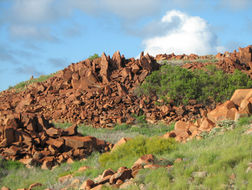CRAR+M Monograph 1
Murujuga Marni: rock art of the macropod hunters and mollusc harvesters
Dr Ken Mulvaney

The Dampier Archipelago, known by its indigenous name Murujuga, comprises a set of 42 islands and, what is now, Burrup Peninsula. Containing one of the world’s greatest collection of petroglyphs. Located on the north-west coast in the subtropical-arid Pilbara region of Western Australia. This rock art, recognised as a masterpiece of human creativity, displays a wide range of styles, techniques and subjects; much more than is usually associated with a single rock art province. These petroglyphs are set in a cultural landscape integrating natural and cultural features. Positioned alongside surface expression of a range of archaeological material, including shell middens, stone arrangement, grinding patches, artefacts scatters and rock quarries.
Traditional lands of the Yaburara, historical events, including an 1866 smallpox epidemic, the 1868 Flying Foam Massacre, and colonial policies and practices, have all significantly impacted the Yaburara people and their cultural lifeways. Yaburara and adjacent groups through the Murujuga Aboriginal Corporation now care for this Country.
Murujuga Marni, the rock art of Dampier Archipelago, sets out to bring an understanding of the artistic phases, environmental influences and cultural traditions that brought about the production of an estimated one million images. This is achieved through analysis of petroglyph weathering condition (a proxy for age), cases of superimposition (where one image overlays another) coupled to changing environmental conditions, species habitat and extinction.


Five distinct artistic traditions and two less clear stylistic divisions are evident in a temporal sequence that may span 30-40,000years. There are clear distinctions with a terrestrial landscape and subsequent marine ecology, this change brought about through the postglacial marine transgression. The rising sea-level and encroaching ocean that formed the archipelago is clearly marked by the dominance of marine species in the zoomorphic art of the last 10,000 years. The first art production many tens of millennia older.
About the Author
For 40+ years Ken engaged in the field of archaeology and anthropology, with a particular interest in indigenous engagement and site protection. With a wide range of expertise within cultural heritage management and rock art research. Ken has been a member of the Australian Rock Art Research Association almost from when it started in 1984 and its President from 2000-09. Research has focused on the Aboriginal association of images, sacred sites and ethnologies. For much of Ken’s working life he has been resident in the Northern Territory or the Pilbara region of Western Australia.


In addition to site mapping and documenting cultural knowledge, Ken has participated in or managed archaeological excavations in countries as diverse as Australia, Africa, England, and Papua New Guinea. For ten years he also was the Expert Adviser to the Northern Territory Coroner on Aboriginal human remains. Graduating from Sheffield University, England with a Bachelor of Arts (Hons) in 1980. During employment stints, Ken also gained his Masters Degree at Northern Territory University in 1997 and his Doctoral Degree at the University of New England in 2010. The PhD focuses on the Murujuga petroglyphs and became the subject of the UWA Press book published in 2015.
















